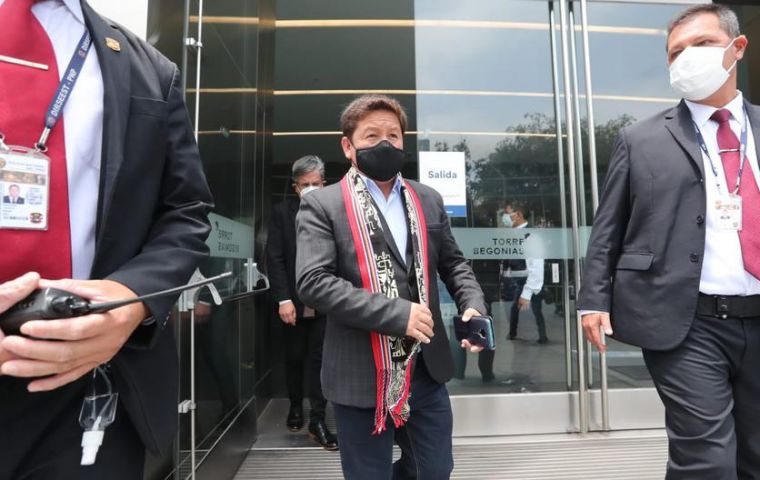MercoPress. South Atlantic News Agency
Peruvian currency plunges against US dollar following PM's nationalization threat against gas supplier
 Bellido delivered a letter to the Argentine company Pluspetrol demanding the price of gas be renegotiated
Bellido delivered a letter to the Argentine company Pluspetrol demanding the price of gas be renegotiated The Peruvian sol fell sharply Monday against the US dollar in Lima markets following Sunday's statements from Prime Minister Guido Bellido, who threatened the new government might stabilize the cooking gas supplier Camisea.
Bellido had warned he could nationalize Camisea in case the private owners in charge of the exploitation zone were not willing to review the contracts in favour of the State.
The US currency started Monday with an upward path and reached a maximum peak of 4,127 soles. Although at the end of the operations it closed at 4,123 soles, a record price of the dollar in Peru, according to data from the Central Reserve Bank (BCRP).
Bellido's words contrasted those of Peruvian President Pedro Castillo, who had assured just five days before in his speech to the United Nations that under him there would be no expropriations.
To stop the advance of the US currency, the BCRP went out to sell 183 million dollars at the close of the day; at an average exchange rate of 4,126 soles per dollar. So far this year, the dollar has already accumulated an increase of 13.93% in Peru, after closing last year at 3,619 soles.
A few hours after Bellido's controversial message, President Castillo reaffirmed that his government is committed to bringing affordable gas to all Peruvians and he insisted any negotiation will take place with unrestricted respect to the rule of law and ensuring national interests.
Currently, the Peruvian Constitution does not contemplate the possibility of nationalization. And the socialist Peru Libre party does not have enough votes in Parliament to reform the Magna Carta, in force since 1993.
But Bellido was seen Monday at the Lima headquarters of the Argentine company Pluspetrol, the majority partner of the Camisea consortium, to deliver a letter whereby he formally urged the company to negotiate to increase profits in favour of the State.
Meanwhile, Minister of Energy and Mines Iván Merino insisted before Parliament's Budget Committee that a renegotiation was necessary. He said hydrocarbon and mining should pay more taxes since they make up for 21% of the country's tax collection when it generates more than 60% of exports.
Pluspetrol has been operating the natural gas field of Camisea, located in the southeastern Amazon of the country, since 2004.
“We call on the Camisea gas operator and marketer to renegotiate the distribution of profits in favour of the State. Otherwise, we will opt for the recovery or nationalization of our field,” Bellido had said on his Twitter account Sunday.
“We need to have gas in the country that is accessible to those who have the least. Today we have access at international costs,” he added.
Bellido later rephrased his statements and stressed the government was to focus on an intense dialogue with the multinational.
Merino said on Monday in a virtual meeting with congressmen from the budget commission, that “the conditions are ripe” for a renegotiation of the profits that the Camisea consortium grants to the State.
According to the National Society of Mining, Oil and Energy, Camisea's gas production capacity is about 1,600 million cubic feet per day. Of these, 600 are exported, another 600 are destined for local consumption and 400 have to be reinjected to the fields due to lack of demand.
Camisea is the most important gas field in Peru and is located in the Amazon part of the southeastern Cusco region. The consortium made up of Argentina's Pluspetrol, the American Hunt Oil, the Surcoerana SK Innovation, the Argentine Tecpetrol, the Spanish Repsol and the Algerian Sonatrach, is producing natural gas and condensate from Blocks 88 and 56.
Camisea is the most important gas project in Peru because it contributes more than 40% of the energy in the entire country. It produces 92% of Peru's controlled natural gas production. Its gas makes it possible to generate more than 40% of the electricity consumed nationwide.




Top Comments
Disclaimer & comment rulesCommenting for this story is now closed.
If you have a Facebook account, become a fan and comment on our Facebook Page!